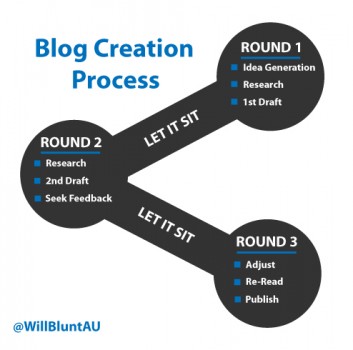 Researching, writing and promoting blogs has become somewhat of an obsession of mine in recent times. One question I often ask myself is; What is it that separates my most shared posts from the ones that go unnoticed?
Researching, writing and promoting blogs has become somewhat of an obsession of mine in recent times. One question I often ask myself is; What is it that separates my most shared posts from the ones that go unnoticed?
Not long ago I wrote a blog for Bluewire Media called ‘Your Ultimate Blog Checklist’ that has been shared on social media over 1200 times, a new record for their blog! My Twitter mentions went from on average 30 a week to over 400 a day… This was new ground, an unfamiliar experience.
This experience forced me to reflect. Why did that blog get shared more on social media compared to other blogs I have written? During this reflection I came up with the ‘Blog Creation Process’, which is what I will discuss in this post. Couple this lengthy writing process with a big whack of discipline and the right promotional tactics, and people will want to share your content because it’s both deliberate and thoughtful.
Round 1 – Blog Creation Process
1. Idea Generation
Coming up with quality blog ideas on a regular basis is difficult. We all know that content is a king, but filling an endless editorial calendar and following through with that commitment is a different ball game. That’s what makes this stage of the blog process extremely important. Here are a couple of tactics I use to come up with blog ideas that you may find helpful;
- Figure out your keywords
Understanding what keywords your readers or customers are searching for is very important. However, if you try and rank for words that are highly competitive like ‘dog’ or ‘cat’ you won’t get discovered in search engines. Alternatively if you get TOO specific with your choice of keywords you are making far too many assumptions about what phrases your readers are searching, and again you probably won’t get discovered. There is a sweet spot somewhere in between these extremes, I certainly haven’t nailed it yet! But for now here are a couple of helpful tools for finding that sweet spot;
- Trawl your favourite blogs
Use tools like BuzzSumo, Feedly or QuickSprout to understand what your favourite blogs are talking about and jot down all the ideas you can find as regularly as you can. Stay up to date!
- See what your competitors are talking about
QuickSprout Site Analyser (Hint: Use the Quicksprout site analyser to understand the keywords your competitors or similar blogs are ranking for. See the image below to see what I mean using the Buffer Blog as an example.)
- Know your reader
What are their biggest challenges? What motivates them to read content online?
This is perhaps the biggest and hairiest suggestion of them all. Why are you even writing a blog in the first place? If you don’t anchor every single bit of content back to this reason and come from an extremely authentic place, your efforts to build an audience will be as progressive as a mouse on a wheel.
As a starting point, get active on Quora or join the discussion in LinkedIn Groups and Google+ Communities so you know what your readers are talking about.
- Dive deeper on your best blogs
What resonated from previous blogs you have written? What sparked conversation with your audience? For example in this blog I am going into more depth on one very specific component of another blog post (Read it here).
2. Research
Once you have nailed down your topic in the idea generation step, it is now time to research that topic. Ask yourself these questions;
- What else is already written about this topic?
- How successful have these other posts or articles been? (What metrics matter?)
- Can these other posts or articles expand your knowledge and help you write a better blog?
- How are you going to put a unique spin on the topic? Why will people care?
Some great tools for conducting this research are;
BuzzSumo
Topsy
Advanced Twitter Search
3. 1st Draft
Many bloggers don’t take the time to write a first draft. I have found that this can be a great discipline for overcoming ‘writer’s block’. In the past I have sat down with pages and pages of blog ideas, and no blogs. It became an ultimate frustration of mine that I couldn’t shift from idea generation to 1st draft. One tactic that has helped minimise that frustration is to start with a high-level structure. Next time you are struggling with this stage of the blog creation process, try this;
- Take your keyword(s) from the idea generation phase and come up with 10-15 possible blog headlines.
- Think about the research you have just done, and your hands on experience. Combine these two things to come up with a basic structure for your blog. Some key dot points and sub-headings.
- Write your introduction and conclusion that support these sub-headings and key dot points.
4. Let it sit
Once you have a base structure for your blog post, let it sit. Rest your mind for an hour, a day, a week. Whatever works for you. But make sure you have time to clear your head and come back in Round 2 with a new vibrance. The worst thing you can do is try and write a blog post from start to finish at the end of a long day.
Round 2 – Blog Creation Process
5. Research
Now that you’ve got a base structure for your blog post, padding it out with valuable content becomes much easier. With a fresh mind, now try and prove your sub-headings and dot points with other research. During this step I focus on finding these inputs;
- Links to other blogs or articles that add depth to your post and increase its credibility. This also helps you reach out to the authors of these posts in an attempt to gain exposure!
- Tools that you use, off or online, that help you do the things you are writing about. These insights are invaluable to your reader so they can replicate the things you are talking about. Think WordPress plugins, helpful products or free online services. For example I have recommended BuzzSumo and QuickSprout in this post.
- Visuals. What visuals will add depth and rigour to your written word? Think screenshots, infographics, images, videos etc.
6. 2nd Draft
You’ve locked down your keywords, created a structure and done the research. Now its time to stop procrastinating and put your fingers on that keyboard and write! Add the mortar to your brick structure. The visuals, the narrative, the useful links etc. Use this step of the process to iron out spelling and grammar errors, make sure you don’t repeat yourself and sense check your blog from start to finish. I use a checklist to make sure all my blogs are anchored to a similar benchmark. I covered this in ‘Your Ultimate Blog Checklist’.
(Disclaimer: I am always adapting this checklist based on what is working, what is best practice and what is changing in the blogosphere)
7. Seek feedback
Ask anyone if they ‘like’ to receive feedback and most will tell you they do. The truth is, their behaviour usually tells you something different. People avoid confronting feedback, and even fewer people take feedback on board and pivot or adapt based on that feedback. If there is one bit of advice I can give, it is to be open to receiving feedback. The best way to accelerate your development as a blogger is to proactively seek feedback, implement that feedback, and don’t make the same mistakes more than once.
The key to valuable feedback is to ask for something simple. Whether it’s a friend, a colleague, a mentor or a family member. Any alternate set of eyes can add incremental value. A couple of example questions to ask;
- Does it make sense?
- Are there any spelling or grammatical errors?
- Is there anything you would add?
- Was it easy to read?
8. Let it sit
Just like in Step 4 it’s time to take a break again. Rest your mind one last time in preparation for the home straight. Take this time to reflect on your feedback and discover where you can make final improvements.
Round 3 – Blog Creation Process
9. Adjust
The reflection time you had in the previous step will allow you to sit back down and put the final touches on your post. What are the big gems that you can add, eliminate or polish to take your blog to the next level?
If the feedback and reflection process has made you realise the blog is adding no value, you may need to pivot back to an earlier stage in the blog creation process. I’m in no way attached to my ideas or the writing that supports them, and either should you be. There is no point in publishing below average content, take on the feedback you receive, and put it into practice regardless of how confronting it may be.
10. Re-Read
Re-read, re-read, and re-read one more time. Spelling and grammar errors are a sure fire way to decrease your credibility as a writer. This is one very last sense check before you hit the publish button.
11. Finalise Headline and Publish
Remember those 10-15 headlines you mapped out in the 1st draft step? Now it’s time to pick your favourite one and put it into the content management system. Which headline will get more people to click on your blog post? Which headline is easy to share?
Once you’ve decided which headline to go with, hit that button! You’ve just created a compelling piece of content that is far more likely to engage with your readers and spread like wildfire on social networks.
If you remember the reason for me reflecting and codifying the ‘Blog Creation Process’ it was to better understand why my blog ‘Your Ultimate Blog Checklist’ went viral. Shift, pivot and adapt this process into something that suits your style. If you codify your own process and combine that with a sprinkling of discipline, the readers and sharers will follow.
I turned the ‘Ultimate Blog Checklist’ into a PDF, and you can download it for free here!

